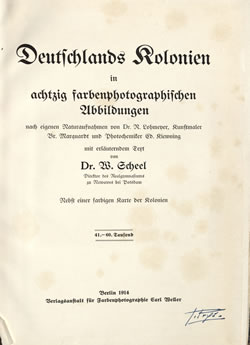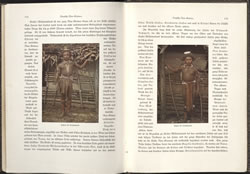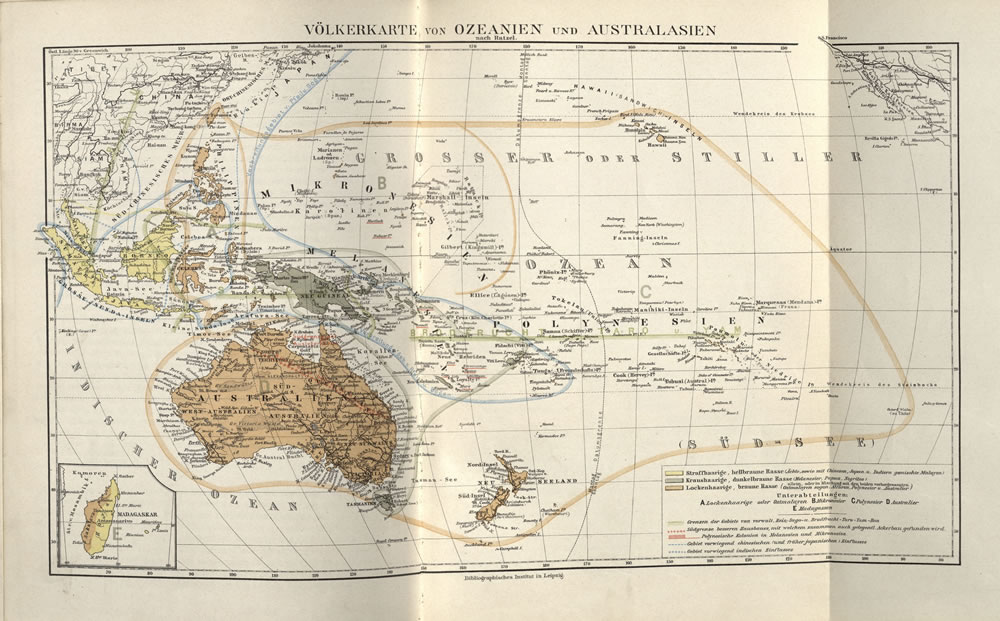Anthropology & Ethnology
Wilhelm Bergmann. Die Kamanuku: die Kultur der Chimbu Staemme, eine monographie
1969
Wilhem Bergmann (b. 1899 Westphalia, d. 1987 Queensland) was one of the first German missionaries allowed back into Papua New Guinea after World War I. He spent forty years in the New Guinean highlands with his wife and their seven children. In 1936 Bergmann applied for membership to the Nazi party but was rejected as a member of the clergy. At the end of World War II, Bergmann was interned in Australia where he maintained his Nazi views. Initially slotted for deportation to Germany, Bergmann received permission to return to New Guinea in 1947 as a missionary. The typewritten text on display stems from Bergmann’s self-published four-volume anthropological monograph on his time among the Chimbu tribes in the Western Highlands of Papua New Guinea. The chart lists the measurements of various body parts of Chimbu men, including head circumference.
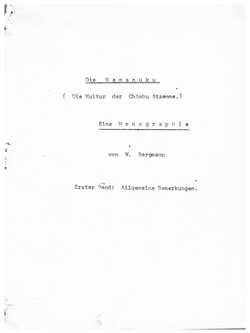
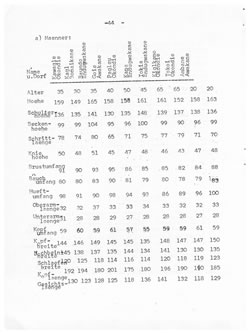
Adolf Bernhard Meyer. Über hundert fünf und dreissig Papúa-schädel von Neu-Guinea und der Insel Mysore
Dresden: 1878
Adolf Bernhard Meyer (b. 1840 Hamburg, d. 1911 Dresden) was a German anthropologist and ornithologist, and he translated many works of the Darwinist Alfred Russell Wallace into German. Meyer traveled to various parts of the Pacific between 1870 and 1873, acquiring a wide range of objects and specimens. He sold his collection to museums in Britain and Germany, including the natural-historical museum in Dresden. In 1874 he was appointed as its director and reorganized it into the Königlich Zoologisches und Anthropologisch-Ethnologisches Museum (Royal Anthropological and Ethnographic Museum in Dresden), which he headed until his retirement in 1905.
Among Meyer’s many writings is a pseudo-scientific phrenological study of 130 skulls and corpses Meyer acquired in Papua New Guinea during his travels. As his foreword reveals, Meyer was very proud of acquiring this large collection because up to this point only individual skulls had been brought to Europe. He believed that he had found a scientifically sound sample for “determining the type of the Papua-race skull.” The pages on display show that Meyer took extensive measurement of the skulls and other body parts. Of note is Meyer’s gender-specific interest in measuring the pubic and pelvic bones of dead Papua New Guinea women.
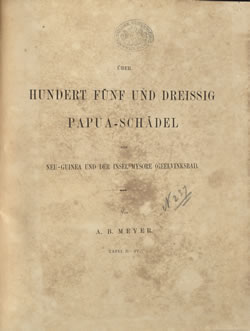
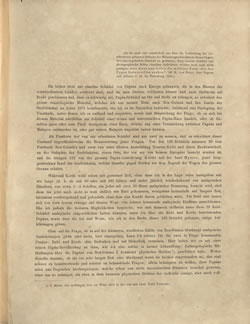
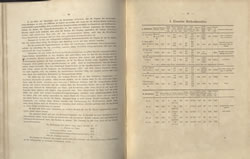
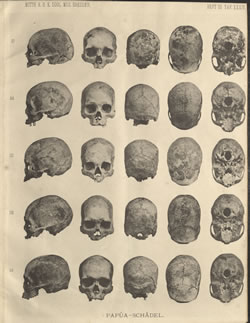
M. V. Thierfelder. Aus dem lande der Marindinesen: Vortag, gehalten in der Ortsgruppe Batavia am 14. juni 1937
Tokyo: 1938
This published lecture by the self-declared ‘racial scientist’ M.V. Thierfelder focused on the Marind of South New Guinea and their place among the ‘concert of peoples’ (Völker). Thierfelder gave the lecture to the Nazi association of Batavia in Dutch Indonesia in 1937. The published version was printed under the aegis of the German Society for the Study of Nature and Peoples in Ostasia in Japan (Tokyo) and Germany (Leipzig). The image depicts a Marind woman whom Thierfelder stereotypes ‘’typical pure race, strongly semito-hamitic’
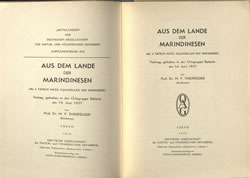
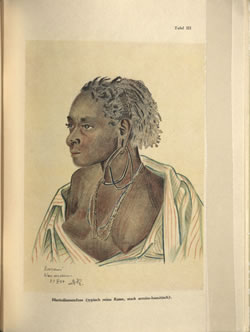
Wilhelm Sievers. Australien und Ozeanien : eine allgemeine Landeskunde
Leipzig: 1895
The geologist and geographer Wilhelm Sievers (b. 1860 Hamburg -1921) published a geographic work that for decades set the standard for world geography. This is the volume dedicated to Australia and Oceania. At the right bottom of the map on display Sievers inserted a legend that offered a racial classification of the peoples of the Pacific based on the texture and color of their hair.
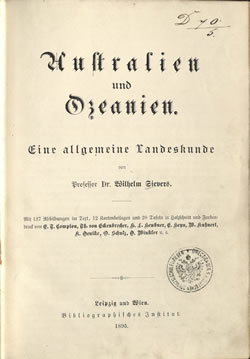

Paul Hambruch. Südseemärchen aus Australien, Neu-Guinea, Fidji, Karolinen, Samoa, Tonga, Hawaii, Neu-Seeland
Jena: 1916
The ethnologist Paul Hambruch (b. 1882 Hamburg, d. 1933) was a member of the expedition team of the Große Hamburger Südsee-Expedition in 1909 and 1910. His primary assignment was the ethnographic study of Micronesia; he authored important works on Nauru and Pohnpei in particular. In 1922 he was appointed Professor Ethnology in Hamburg. During his journey to the South Sea, Hambruch collected fairytales that he published in this volume in 1916 with an eye towards a broader public. The binding is evocative of island life with its choice of palm fibers and spear design.
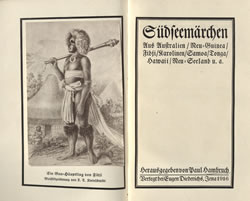
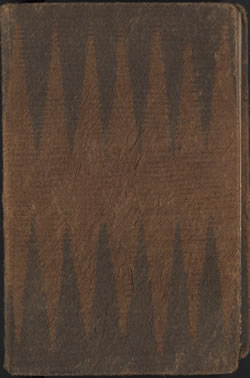
Adolf Bernhard Meyer. Album von Papúa-Typen II: Nord Neu-Guinea, Bismarck Archipel, Deutsche Salomo-Inseln, etwa 550 Abbildungen auf 53 Tafeln in Lichtdruck
Dresden: 1900
This photo album featuring the indigenous peoples of New Guinea and the Bismarck Archipelago is a sequel to an album that appeared in 1894. This volume was published in Dresden in 1900. R. Parkinson provided the images. He was a photographer based in New Britain, the largest island in the Bismarck Archipelago, who traveled the region as a guest on cruise and company boats. Adolf Bernhard Meyer (b. 1840 Hamburg, d. 1911 Dresden) arranged the images, wrote the text, and oversaw the publication in Dresden. A German anthropologist, Meyer was the director of the Königlich Zoologisches und Anthropologisch-Ethnologisches Museum (Royal Zoological and Anthropological and Ethnographic Museum) in Dresden between 1874 and 1905. Meyer also conducted his travels and research in the Pacific. Case 7 contains a pseudo-scientific craniological treatise that Meyer wrote on the basis of 130 skulls he acquired in Papua New Guinea.
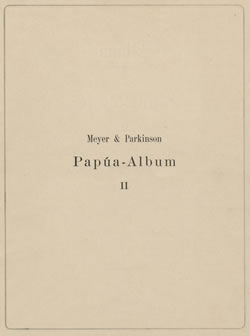
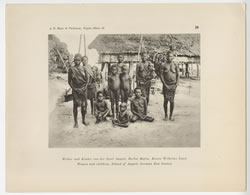
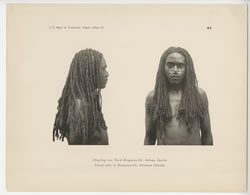
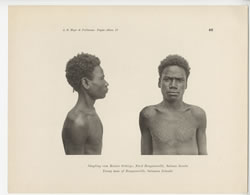
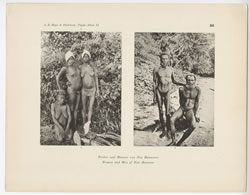
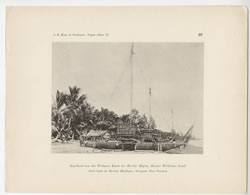
Willy Scheel. Deutschlands Kolonien in achtzig farbenphotographischen Abbildungen: nach eigenen Naturaufnahmen
Berlin: 1914
This is an early and popular example of a photo book about the German colonies. Willy Scheel’s work appeared in multiple editions amounting to 60,000 copies. He acquired the photos from painters and photographers, and wrote the text to go along with the images. The work also included a colorful map of the German colonies. On view here are indigenous people from German Papua New Guinea in their traditional dance attire.
